| |
 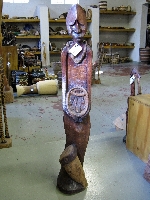 The
Katima Mulilo craft center was closed when we arrived on Sunday.
Interested in not missing it completely, it was
our first stop on Monday morning. Woven baskets is one of its strong
points. There is also a fairly regular assortment of drums, carved hippos,
giraffes, and human busts. But then there were also a few high quality unique
pieces. A statue of a stylized musician was one of my favorites
(right). The
Katima Mulilo craft center was closed when we arrived on Sunday.
Interested in not missing it completely, it was
our first stop on Monday morning. Woven baskets is one of its strong
points. There is also a fairly regular assortment of drums, carved hippos,
giraffes, and human busts. But then there were also a few high quality unique
pieces. A statue of a stylized musician was one of my favorites
(right).
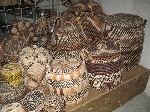 I would have been most likely to buy a basket because
they are light and easy to carry, but there were so many the choice was a
bit overwhelming. I would have been most likely to buy a basket because
they are light and easy to carry, but there were so many the choice was a
bit overwhelming.
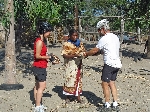 In
contrast, we stopped later in the morning at a stand that looked like it
should have soft drinks for sale. They were out of soft drinks but the
woman there was a basket weaver. When we indicated some interested in the basket
she hurried off to grab the inventory -- three baskets at the
moment. In short order two were sold, and had other members of our
group been there we would have bought out the entire stock. In
contrast, we stopped later in the morning at a stand that looked like it
should have soft drinks for sale. They were out of soft drinks but the
woman there was a basket weaver. When we indicated some interested in the basket
she hurried off to grab the inventory -- three baskets at the
moment. In short order two were sold, and had other members of our
group been there we would have bought out the entire stock.
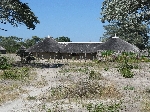 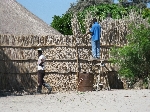 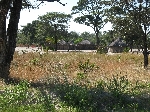 The
architecture of the area still continued to distinguish itself. It would be
legitimate to do a photo essay on the architecture alone. Along the way
there were interesting larger buildings with multiple rooflines, clusters of
buildings set nicely among the trees and the occasion of a palisade fence being
trimmed. The
architecture of the area still continued to distinguish itself. It would be
legitimate to do a photo essay on the architecture alone. Along the way
there were interesting larger buildings with multiple rooflines, clusters of
buildings set nicely among the trees and the occasion of a palisade fence being
trimmed.
 The pattern for
provisions is they are few and far between. It seems that we are lucky
to see a bottle shop or small tack shop The pattern for
provisions is they are few and far between. It seems that we are lucky
to see a bottle shop or small tack shop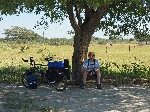 (both small grocery and dry goods
shops) once every twenty kilometers. And too often these were closed.
Maybe the active shops are located further off the road, but one would think
that near the road would be the preferred location for such a business.
Sometimes the best place for a break was a well accessorized tree -- prized
trees come with benches (right). (both small grocery and dry goods
shops) once every twenty kilometers. And too often these were closed.
Maybe the active shops are located further off the road, but one would think
that near the road would be the preferred location for such a business.
Sometimes the best place for a break was a well accessorized tree -- prized
trees come with benches (right).
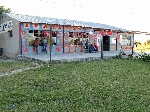

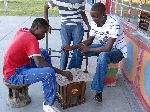
 At
the end of the day our gathering point was the Get Lucky Store. We were
lucky! Dustrick
and Helen, the owners, took great care of us, and an interesting assortment
of other people gathered there as well, At
the end of the day our gathering point was the Get Lucky Store. We were
lucky! Dustrick
and Helen, the owners, took great care of us, and an interesting assortment
of other people gathered there as well, combining for great conversations,
good fun and a generally interesting afternoon. We put our combining for great conversations,
good fun and a generally interesting afternoon. We put our  checkers ace
against the local youth star and we got beat handily. My favorite
quote of the evening was from an older gentleman who kept repeating, "I am a Caprivian, not a Namibian." Knowing that this was the basis of a
recent secessionist movement and the gentleman was probably under the
influence of something, I chose to avoid the opportunity to get involved in
local politics and chose not to question him about any deeper meaning of his
proclamation. It is ironic that Caprivi is derived from the name of a
Prussian / German general / politician (Georg Leo von Caprivi
de Caprera de Montecuccoli, 1831-1899), and Namib
at least has African origins (a Nama word meaning "vast", as in Namib
desert.) checkers ace
against the local youth star and we got beat handily. My favorite
quote of the evening was from an older gentleman who kept repeating, "I am a Caprivian, not a Namibian." Knowing that this was the basis of a
recent secessionist movement and the gentleman was probably under the
influence of something, I chose to avoid the opportunity to get involved in
local politics and chose not to question him about any deeper meaning of his
proclamation. It is ironic that Caprivi is derived from the name of a
Prussian / German general / politician (Georg Leo von Caprivi
de Caprera de Montecuccoli, 1831-1899), and Namib
at least has African origins (a Nama word meaning "vast", as in Namib
desert.)
 The highest concentration of housing in Linyanti is
hardly concentrated and stretches along the road for several kilometers. A
bicycle is a good form of transportation between locations along the road.
There is no hotel, guest house or lodge, no restaurant, no Internet and no gas station, but
there is a safe drinking water system and 24/7 electricity. The "center" of Linyanti is clearly the Get Lucky Store. The highest concentration of housing in Linyanti is
hardly concentrated and stretches along the road for several kilometers. A
bicycle is a good form of transportation between locations along the road.
There is no hotel, guest house or lodge, no restaurant, no Internet and no gas station, but
there is a safe drinking water system and 24/7 electricity. The "center" of Linyanti is clearly the Get Lucky Store.
The place name Linyanti, itself, can create some confusion. In
addition to being a town, it is also used to designate the general area (Linyanti
swamp), and
historically it has been used as the name of several towns, including the
current Sangwali in the 1800's.
Another day, and maybe another language: I believe I was told
that the dominate ethnic group and language in Linyanti is Totela. It at least is spoken
somewhere in the area.
The conversation got distracted before I had a chance to straighten out the
confusion and the language of Linyanti.
|
Addendum:
David Livingstone:
(Source Sangwali Museum)
David Livingstone was the first
European missionary to come to the area. At the time he was working
with the London Missionary Society at Kolobeng, near Gaberone. In June 1851
he and his friend, William Cottton Oswell traveled by ox wagon across the
Makgadikgadi salt pans and the Mabebe Plains to make contact with Sebetoane,
chief of the Makololo. He brought his wife Mary and their three small
children. This was Livingstone’s third attempt to reach the Makololo. At
the time, Sebetoane had his headquarters at Sangwali, which was then
known as Linyanti.
In July 1851, soon after
Livingstone’s arrival, Sebetoane died. Livingstone returned to the Cape to
Send Mary and the children to the UK and two years later, in May 1853 he
returned with his drivers and bearers to try to find an outlet from the
Zambezi to the sea. He found Sekeletu had succeeded his father Sebetoane as
chief of the Makololo.
Making Linyanti (Sangwali) his
base, in November 1853 Livingstone set out to explore for a river route to
the west coast. After a long and difficult journey he reached Loanda in
Angola on 31 May 1854. He found there were too many obstacles and failed to
discover a suitable route. He therefore returned to Linyanti and in
September 1855 he set off for the east coast, following the Kafue and then
the Zambezi rivers. He promised Sekeletu he would be back with his wife to
open a missionary station at Linyanti.
(cont)
|
|
David Livingstone (cont)
It was at this time, on
16 November 1855, that Livingstone first saw the great falls called Mosi
oa tunya, which he re-named Victoria Falls. He arrived at Quelimane in
Mozambique on 20 May 1856. Returning to England, he declared that the river
route from the Batoka plain could be used to carry goods to the east coast.
In May 1858 Livinstone
returned to the mouth of the Zambezi on the east coast with an expedition
party, to carry out further exploration on behalf of the British
government. It was then that he found that the rapids where the Cahora
Bassa dam now is near Tete were, in fact impassable and that there was no
river route to the Makololo. He decided to explore the rivers Rovuma
and Shire in Malawi instead.
In August 1860
Livingstone returned overland to Linyanti to bring his Makololo porters
back, whom he had left at Tete way back in May 1856. He found chief
Sekeletu of the Makololo suffering from leprosy. He left the Linyanti
in September 1860 to return to the east coast and never visited this region
again.
Livingstone continued to
explore central Africa. He reached the shores of Lake Nyasa (now Lake
Malawi) in 1859. In July 1863 the British government recalled his
expedition and he returned to England. Two years later he came back to
Africa, where he remained for the rest of his life. He spent his last years
trying to find the source of the Nile. He died at Chief Chitambo’s village
at Bangweulu on 1 May 1873.
Livingstone
opened up the heart of Africa and brought it to the attention of Europe. He
was considered one of the great explorers of his time. He was a popular
Victorian hero, but modern historians judge him more critically. He failed
as a husband and father. He failed as a missionary. He failed Chief
Sechele and the Bakwena when he left Kolobeng and he failed to keep his
promise to Sekeletu of the Makololo. The Zambezi Expedition was a
disaster. Above all, he failed to support the Helmore/Price Expedition. On
the other hand, Livingstone’s greatest achievement was to open up Central
Africa and to bring about an end to the slave trade in Africa. He had seen
first hand the terrible effects on individuals and on communities and
brought it to the attention of the world. Alas, he did not live to see its
final abolishment in Africa by the end of the nineteenth century. |















